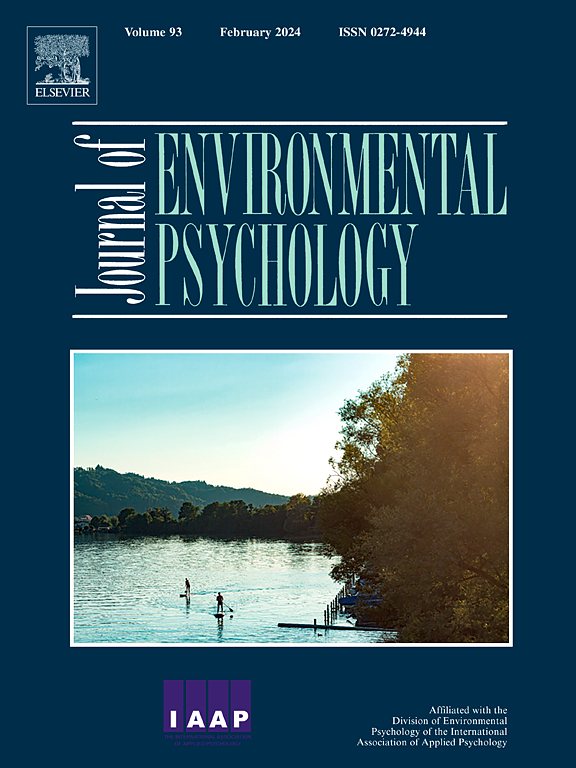要(不)进入吗?室内场景的客观视觉特征预测了趋近-回避反应和核心情感
IF 7
1区 心理学
Q1 ENVIRONMENTAL STUDIES
引用次数: 0
摘要
关于感知和偏好的环境心理学理论在预测对环境场景的情绪和行为反应方面取得了长足的进步,但客观场景特征与人类经验之间的差距仍然存在。大多数现有的研究依赖于感知属性的主观资格,或者一次检查少数客观视觉特征的影响,只捕获了现实世界场景复杂性的一小部分。本研究的新颖之处在于利用视觉感知和计算机视觉的进步,客观地量化描绘日常室内环境的360张照片上的低、中、高视觉的大量视觉特征,并检查这些视觉水平对情感和避近反应的个体和综合影响。这些特征在自举逐步回归中用于预测在受控环境中60名参与者的回避、效价、紧张和能量唤醒的主观反应。结果表明,低、中、高水平的视觉特征在所有结果测量中都占了相当大的方差,无论是共同的还是每个单独的水平。随后的方差划分分析表明,不同层次的视觉特征之间的解释力是共享的,其关系取决于目标变量。某些视觉特征,如边缘的数量、包围的程度和植物的存在,证实了环境偏好的关键理论所提出的关系,而其他一些视觉特征,如平均亮度,虽然没有被理论讨论,但却成为重要的预测因素。这项工作证明了在环境偏好研究中客观量化各个层次视觉感知特征的能力,并推进了我们对视觉特征与室内环境情绪反应之间关系的理解,突出了该领域对更详细理论的需求。本文章由计算机程序翻译,如有差异,请以英文原文为准。
Do (not) enter? Objective visual features of indoor scenes predict approach-avoidance responses and core affect
Environmental psychology theories on perception and preference have come a long way to predict emotional and behavioral responses to environmental scenes, yet the gap between objective scene characteristics and human experience remains. Most existing studies relied on subjective qualifications of perceptual attributes, or examined the influence of few objective visual features at a time, capturing only a small part of the complexity of real world scenes. The novelty of this study lies in drawing from visual perception and advancements in computer vision to objectively quantify a large set of visual features from low-, mid-, and high-level vision on 360 photographs depicting everyday indoor environments and examine both the individual and combined effects of these visual levels on affective and approach-avoidance responses. These features were used in bootstrapped stepwise regressions to predict subjective responses of approach-avoidance, valence, and tense and energetic arousal, collected from 60 participants in a controlled environment. Results show that low-, mid-, and high-level visual features accounted for a substantial amount of variance in all outcome measures, jointly as well as per separate level. Subsequent variance partitioning analyses showed that explanatory power was shared between visual features from different levels with a relationship that depended on the target variable. Certain visual features, such as the number of edges, degree of enclosure, and presence of plants confirmed relationships proposed by key theories of environmental preference, while others, such as mean brightness, emerge as important predictors despite not being discussed by the theories. This work demonstrates the capabilities of objectively quantifying features from all levels of visual perception in environmental preference research, and advances our understanding of the relationship between visual features and emotional responses to indoor environments, highlighting the need for more detailed theories in this domain.
求助全文
通过发布文献求助,成功后即可免费获取论文全文。
去求助
来源期刊

Journal of Environmental Psychology
Multiple-
CiteScore
10.60
自引率
8.70%
发文量
140
审稿时长
62 days
期刊介绍:
The Journal of Environmental Psychology is the premier journal in the field, serving individuals in a wide range of disciplines who have an interest in the scientific study of the transactions and interrelationships between people and their surroundings (including built, social, natural and virtual environments, the use and abuse of nature and natural resources, and sustainability-related behavior). The journal publishes internationally contributed empirical studies and reviews of research on these topics that advance new insights. As an important forum for the field, the journal publishes some of the most influential papers in the discipline that reflect the scientific development of environmental psychology. Contributions on theoretical, methodological, and practical aspects of all human-environment interactions are welcome, along with innovative or interdisciplinary approaches that have a psychological emphasis. Research areas include: •Psychological and behavioral aspects of people and nature •Cognitive mapping, spatial cognition and wayfinding •Ecological consequences of human actions •Theories of place, place attachment, and place identity •Environmental risks and hazards: perception, behavior, and management •Perception and evaluation of buildings and natural landscapes •Effects of physical and natural settings on human cognition and health •Theories of proenvironmental behavior, norms, attitudes, and personality •Psychology of sustainability and climate change •Psychological aspects of resource management and crises •Social use of space: crowding, privacy, territoriality, personal space •Design of, and experiences related to, the physical aspects of workplaces, schools, residences, public buildings and public space
 求助内容:
求助内容: 应助结果提醒方式:
应助结果提醒方式:


